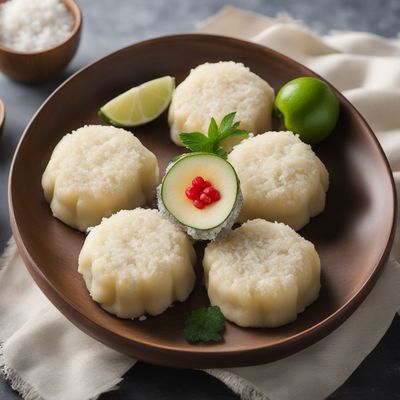
Ingredient
Cheese, butterkase
The Creamy Delight
Butterkase cheese, originating from Germany, is a semi-soft cheese made from cow's milk. It has a pale yellow color and a smooth, creamy texture. The cheese is known for its mild and buttery flavor, making it a versatile ingredient in various dishes. It pairs well with fruits, bread, and crackers, and can be melted easily, making it ideal for sandwiches and fondues.
Origins and history
Butterkase cheese has its roots in Germany, where it was first produced in the mid-19th century. The name 'butterkase' translates to 'butter cheese,' which accurately describes its rich and buttery flavor. Over time, it has gained popularity not only in Germany but also in other parts of Europe and the United States.
Nutritional information
Butterkase cheese is a good source of calcium and protein, providing essential nutrients for bone health and muscle development. It is also relatively low in lactose, making it suitable for individuals with lactose intolerance. However, it is important to consume it in moderation due to its high fat content.
Allergens
Butterkase cheese is made from cow's milk, so individuals with dairy allergies should avoid it. Additionally, it contains lactose, so those with lactose intolerance should consume it in moderation or opt for lactose-free alternatives.
How to select
When selecting butterkase cheese, look for a cheese that is pale yellow in color and has a smooth and unblemished rind. The cheese should feel slightly firm to the touch but still yield to gentle pressure. Avoid cheeses with any signs of mold or an overly strong aroma.
Storage recommendations
To maintain the freshness and quality of butterkase cheese, store it in the refrigerator at a temperature between 35°F and 40°F (1.7°C and 4.4°C). Keep it wrapped in wax paper or parchment paper to allow it to breathe and prevent moisture buildup. Avoid storing it in plastic wrap, as it can cause the cheese to become slimy.
How to produce
Butterkase cheese is typically produced by professional cheesemakers using specialized equipment and techniques. However, if you are an experienced home cheesemaker, you can try making it using fresh cow's milk, rennet, and cheese cultures. Follow a trusted recipe and ensure proper sanitation to achieve the best results.
Preparation tips
Butterkase cheese can be enjoyed in various ways. It is delicious when served on a cheese platter alongside fruits, nuts, and crackers. It melts beautifully, making it an excellent choice for grilled cheese sandwiches, burgers, or paninis. It can also be used in fondues, quiches, and pasta dishes to add a creamy and rich flavor.
Culinary uses
Butterkase cheese is commonly used in German cuisine, where it is enjoyed on bread or as a topping for warm dishes. It is also a popular choice for melting, making it a staple in grilled cheese sandwiches and cheeseburgers. Additionally, it can be used in quiches, casseroles, and macaroni and cheese to add a creamy and indulgent touch.
Availability
Butterkase cheese is primarily produced in Germany, where it originated. However, it is also available in other European countries, such as Austria and Switzerland. In the United States, it can be found in specialty cheese shops and some supermarkets.
More ingredients from this category » Browse all

Cheese, hushallsost
The Swedish Delight: Hushallsost - A Creamy and Nutty Cheese

Cheese, abondance
The Savory Delight: Abondance Cheese

Cheese, piacentinu
Piacentinu: A Sicilian Delight of Cheese

Cheese, colby
"Colby Cheese: The Creamy Delight with a Mild Twist"

Cheese, vignerons
The Artisan's Delight: Vignerons Cheese

Cheese, asiago
"Aged Delight: Unveiling the Richness of Asiago Cheese"

Cheese, cantal
The Versatile Delight: Cantal Cheese

Cheese, toma piemontese
The Creamy Delight

Cheese, graddost
Graddost Delight

Cheese, chimay
The Belgian Delight: Chimay Cheese

Cheese, marechal
The Bold and Robust Marechal Cheese

Cheese, raschera
The Creamy Delight: Unveiling the Secrets of Raschera Cheese
